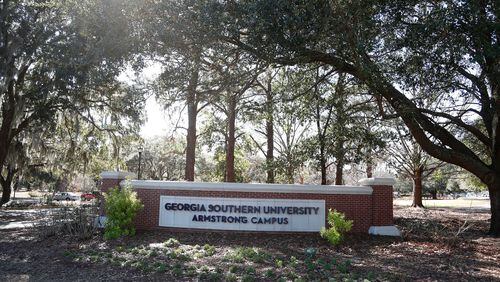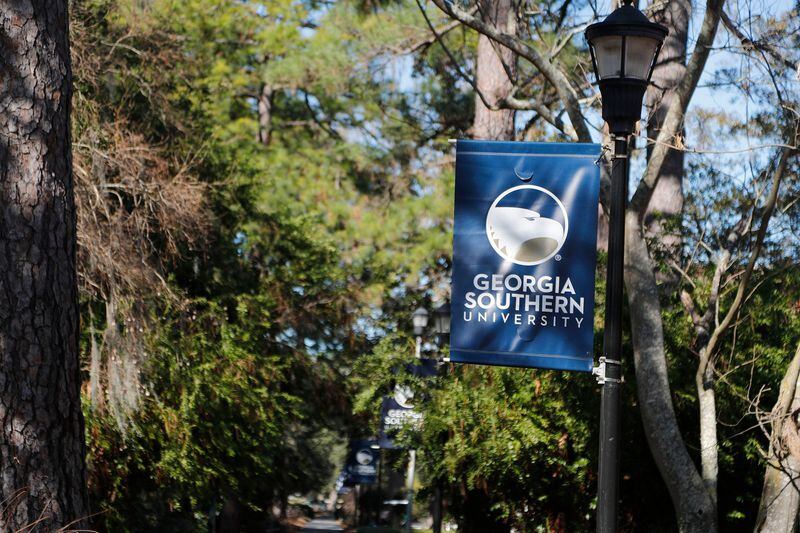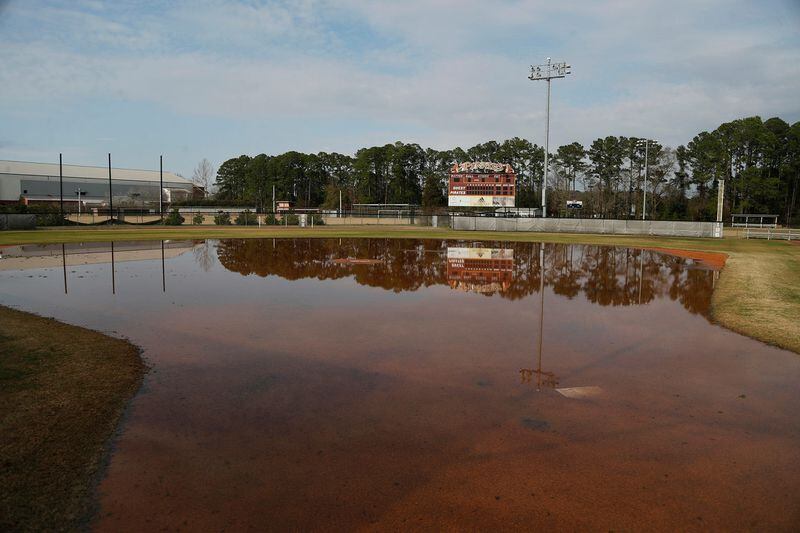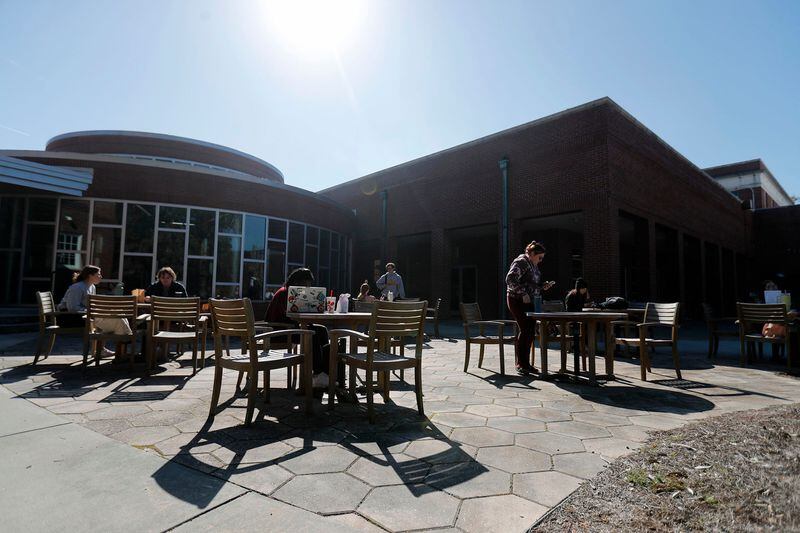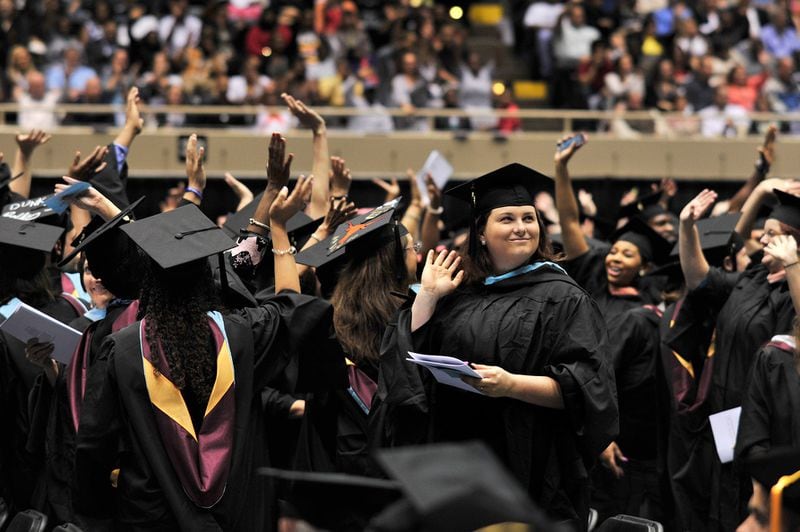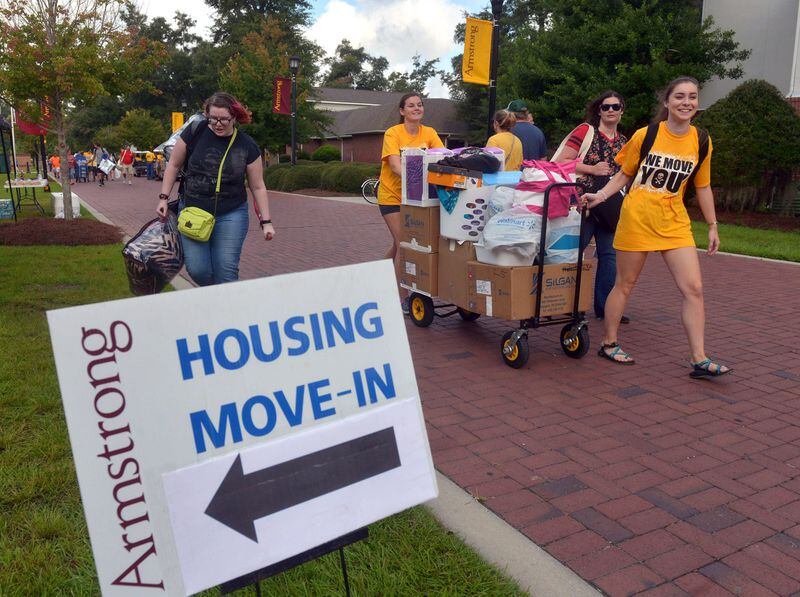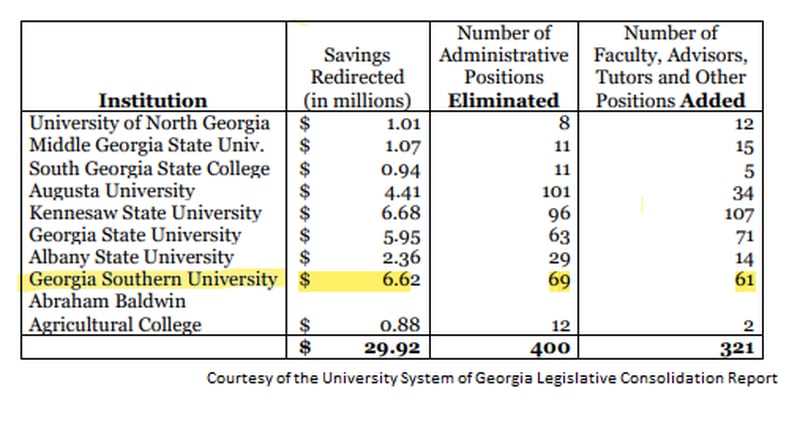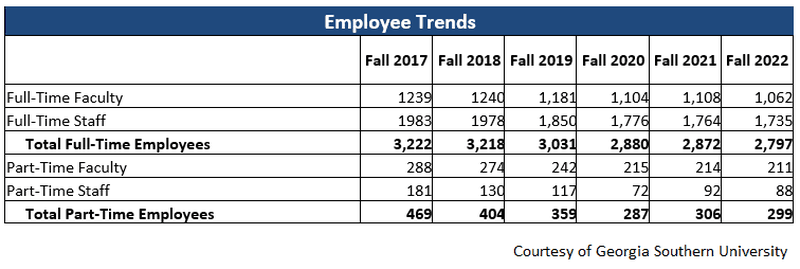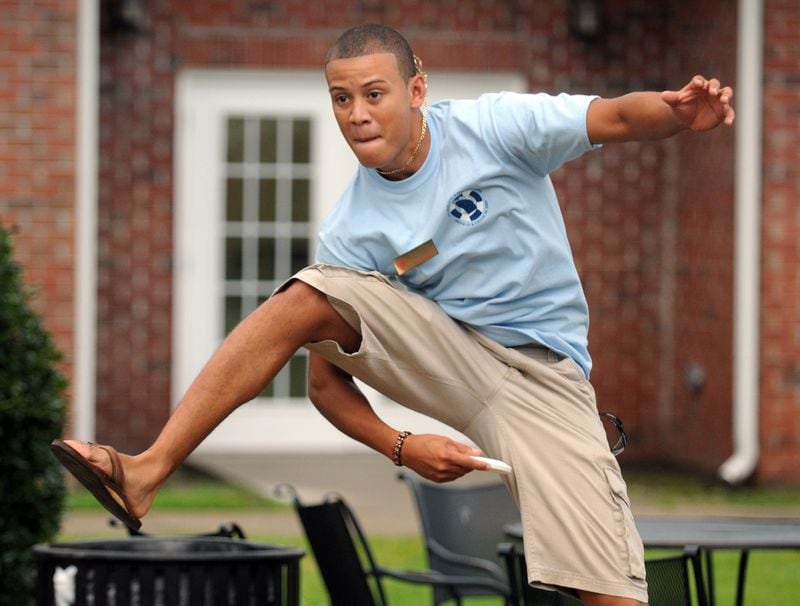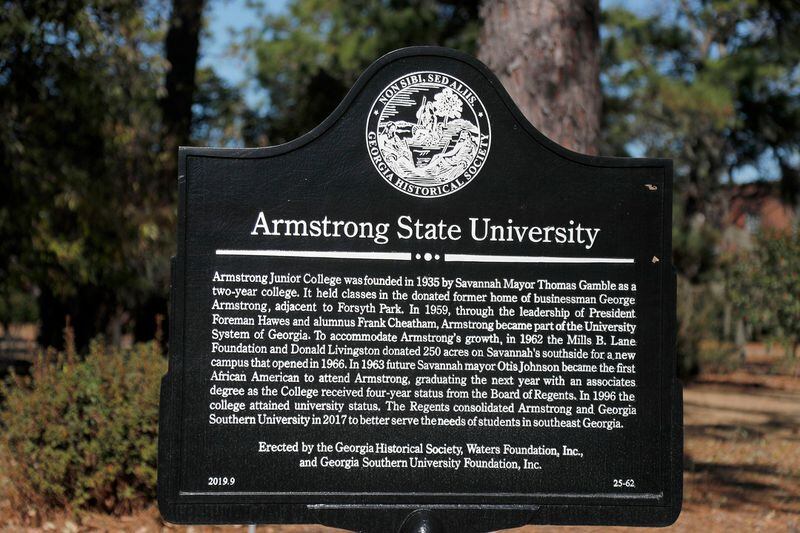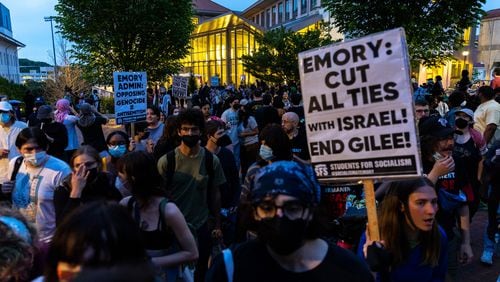Five years ago this month, Armstrong State University students watched as crews removed the many blazing red flags bearing a Pirate logo from around the southside Savannah campus and replaced the banners with Georgia Southern University pennants emblazoned with a white eagle head.
The flag swap followed the consolidation of the two state-run universities in January 2018. The merger was meant to better the educational experience for students and make Georgia Southern, already one of the state's largest schools in terms of enrollment, a regional "economic powerhouse" with ties to several of Savannah's growing economic sectors, such as health care, engineering and ports-related industries.
Credit: Richard Burkhart/Savannah Morning News
Credit: Richard Burkhart/Savannah Morning News
The University System of Georgia's then chancellor, Steven Wrigley, said a combined institution would create "tailored degree programs for the coastal region" and "significantly enhance the University System's economic impact for the area."
For many in the Armstrong community - alumni, faculty, students - the merger of their small, Savannah-centric university with Georgia Southern fostered something else: Resentment.
"[The merger] was forced upon the community with no debate," said David Breland, a 1989 Armstrong alum part of a legacy family. "I heard from several people that they avoid looking at the campus on Abercorn as they drive by and still do."
The Armstrong-Georgia Southern merger was one of several consolidations mandated by the University System of Georgia (USG) half a decade ago. State funding cuts forced USG's governance body, the Board of Regents, to evaluate the funding model. They could raise tuition, reduce faculty or explore other expense-cutting measures - such as consolidations, which result in administrative and student services cost savings.
Between 2012 and 2018, USG reduced its 35 colleges and universities to 26 in an aggressive campus consolidation program. Nearly $30 million was saved in administrative costs and reinvested into new staff and resources for the merged universities. Graduation and retention rates increased and enrollment numbers were on the rise.
In Savannah, at what became known as the Armstrong campus of Georgia Southern, the merger brought a myriad of benefits: access to Statesboro resources and activities; new and expanded academic programs; and state-of-the-art venues and building complexes that opened up fresh opportunities to a student population of 7,100 students at the time the merger was announced.
But to critics, the promise of a bigger, better university sounded hollow then - a notion backed by data from the last five years.
Graduation rates have increased since the consolidation. However, enrollment has steadily declined, disproportionately so on the Armstrong campus. About 4,600 students currently attend the Armstrong campus, not including those who attend online. More than half of residence halls sit empty and athletic fields are little used. The school's once-vibrant NCAA Division II athletics program, which fueled the Armstrong Pirate identity, folded with the merger.
Campus life is now a whisper of what it used to be, say the students who were there during the consolidation. For them, talk about success can’t come without acknowledgment of what was lost.
"They kind of just said, 'consolidate and go," said Will White, a spring 2020 history graduate. "Student life took a hit. A lot of clubs fell apart. Club sports – that all fell apart ... The name Armstrong is kind of meaningless."
Credit: Richard Burkhart/Savannah Morning News
Credit: Richard Burkhart/Savannah Morning News
What was the public reaction to the merger?
The Georgia Southern-Armstrong merger was approved by the Georgia Board of Regents in January 2017, a year ahead of implementation. Backlash against the decision was swift. The Armstrong community criticized the board for not allotting enough time for community input before drafting the consolidation proposal.
On campus protests and social media outcry denounced the move as a business merger. People filled town halls and op-eds poured into local media outlets.
The greater Savannah community questioned whether consolidation was right for the small, commuter school whose enrollment numbers were on an upward trajectory and programs were expanding.
Armstrong's strength was in its accessibility. According to a 2016 plan update, more than a third of students were non-traditional adult learners who needed flexible course offerings. Almost half (46%) of students were Pell Grant eligible and over 85% received financial aid. Armstrong and its satellite campus in Liberty was a top school for armed forces veterans and active duty military in the region as well.
The 60-mile distance between the Statesboro and Savannah campuses would harm the students who relied on Armstrong's convenience and accessibility the most, said community members.
“With the takeover of Armstrong, we were told that GSU would be one of the largest universities in the state. To the Armstrong community, that was a detriment, not a virtue,” said Breland, who led a group that pushed to "Unmerge" the universities for several years after the consolidation. “The citizens of Georgia have one less option.”
Credit: Richard Burkhart/Savannah Morning News
Credit: Richard Burkhart/Savannah Morning News
How was consolidation implemented?
Over the course of 18 months, a 41-member implementation committee with representatives from both campuses embarked on the tedious consolidation process. Seventeen meetings and more than a hundred recommendations went into the final Georgia Southern prospectus.
The two campuses would share eight colleges. Armstrong went from housing four colleges prior to consolidation to three: Education, Health Professions and Public Health. Statesboro houses the colleges of Engineering and Computing, Arts and Humanities, Behavioral and Social Sciences, Business, Science and Mathematics, and Graduate Studies.
More than 200 undergraduate and graduate degree programs between the two schools were consolidated into 142 programs. Pushback came from both sides on how to "blend" the different cultures and missions within the same discipline.
Credit: Joseph Jacob, Savannah Morning News
Credit: Joseph Jacob, Savannah Morning News
But perhaps the biggest blow to school spirit and identity, according to students and faculty, was the dissolution of Armstrong athletics. Student athletes were allowed to try out for Georgia Southern's NCAA Division I teams or transfer to other Division II schools without penalty. Eventually, the Pirates' 50-year legacy was enshrined in the Armstrong Hall of Champions. But no one would wear the Pirates' jersey in competition again.
“Over the winter break, pretty much everything that said Armstrong was gotten rid of. I remember in the student housing area, they got rid of the pirate logo and put an eagle. It was really weird.” said White.
White also saw his rugby team fall apart as athletes moved away and new requirements for club sports made participation more difficult for students. The Rotaract club, a community service-oriented organization, also dwindled. It’s hard to pin down what exactly caused the lack of involvement, though, White said.
“It fell apart during COVID, but the merger didn't help,” said White. “There just wasn’t a push for student life.”
A year after the merger, a campus climate survey cited a drop in morale on the Armstrong campus and opposition to consolidation remained strong. The most vocal opponents formed the "Unmerge" group that distributed yard signs, voiced their dissatisfaction through local media outlets and presented an opposition letter to Gov. Brian Kemp. Those efforts have died down since the COVID-19 pandemic, said "Unmerge" leader Breland.
Credit: Richard Burkhart/Savannah Morning News
Credit: Richard Burkhart/Savannah Morning News
The campus academic culture suffered following the merger as well, according to a former administrator, Greg Anderson. At the time of the merger, Anderson was the director of the Freshman Experience, a program meant to help first-year students adjust to college life. He was also a member of the implementation committee tasked with restructuring the university’s core requirements as part of the consolidation.
“Armstrong was a place of opportunity (prior the merger) … The faculty was deeply engaged with student learning and we would collectively find a way to support students in their journey,” said Anderson, “It wasn’t a utopia, don't get me wrong, but we all had a common goal.”
Once the merger was completed in 2018, the intimate environment was replaced by what Anderson described as a more “corporate structure.” According to Anderson, with major leadership and most departments headquartered at the Statesboro campus, many faculty and staff members felt Armstrong became a “bit of a stepchild."
Then came the post-consolidation reorganization.
Anderson, who had been at the university for 22 years, was told his services as an administrator were no longer needed. Georgia Southern had its own first-year orientation program, known as Eagle Experience, with its own director. Like many Armstrong administrators, Anderson's position became redundant.
The university offered him a teaching position, albeit it a 35% pay cut.
“I basically couldn’t live with that,” he said. “In October 2019, I left.”
Credit: Steve Bisson, Savannah Morning News
Credit: Steve Bisson, Savannah Morning News
How much did consolidation save and where were those dollars reinvested?
All told, USG’s consolidations statewide eliminated about 400 administrative positions and redirected the nearly $30 million in savings to 300 positions that “more directly serve students.”
Georgia Southern eliminated 69 administrative positions and used some of those savings to create 61 new positions for faculty, advisors, tutors and other staff. The GSU-Armstrong consolidation led to $6.6 million in savings, more than all but one of the other mergers
Credit: Courtesy of the University System of Georgia
Credit: Courtesy of the University System of Georgia
Credit: Courtesy of Georgia Southern University
Credit: Courtesy of Georgia Southern University
In the last five years, Georgia Southern has repurposed those dollars in other ways as well.
More than 30 academic programs have been developed or expanded on the Armstrong campus. Some of those programs include logistics and intermodal transportation, public health and hospitality management – degrees geared toward Savannah’s booming logistics and tourism economy.
Expansions to the university’s nursing program and dual enrollment partnership with the Savannah-Chatham County Public School System are in the works as well.
The university is also investing in advising and support services to boost freshmen retention rates, which, like most universities across the country, dipped in the aftermath of the COVID-19 pandemic.
University officials continue to laud the merger as a success, capitalizing on GSU's potential to advance economic growth in the region.
“I think it’s important to note that Georgia Southern now has an expanded reach, a broader economic impact of more than $1 billion and serves as a greater intellectual catalyst for industry in our region,” wrote Provost and Vice President for Academic Affairs Carl L. Reiber.
But from a student's vantage point, that success can feel abstract.
“Those were kind of just selling points,” said White, “it was mainly about cutting down on costs.”
White can pinpoint some of the benefits he reaped: In his sophomore year, he participated in an exchange program in England that wouldn't have been available through Armstrong's smaller, study abroad office. He, like other Savannah-based students, was able to attend Georgia Southern football games at Statesboro's Paulson stadium for free. A shuttle bus that runs between Savannah and Statesboro eased travel for students as well.
He recognizes that opinions on the merger depend on who you ask. While White was able to finish his degree on the Armstrong campus, some of his peers couldn't.
Credit: Steve Bisson, Savannah Morning News
Credit: Steve Bisson, Savannah Morning News
How has the merger affected current students?
Anthony Crimely, a music education major, found out in his second year that he'd have to finish his degree on the Statesboro campus - contrary to what faculty told him when he first enrolled at Armstrong in 2019. That same year, the university migrated most music degrees to Statesboro, and Crimely became one of the last few music education majors at Armstrong.
To him, it felt like a bait and switch.
He called the 60-mile commute from Savannah an “impossible task" and instead moved to Bulloch County. The euphonium player noticed a difference in the scene almost immediately. Statesboro was a lively college campus.
"There are more people, more things to do - both positive and negative," he laughs.
Credit: Richard Burkhart/Savannah Morning News
Credit: Richard Burkhart/Savannah Morning News
But he misses the close-knit atmosphere at Armstrong, where everything he needed was within a five-minute walk. And though Crimely believes the Armstrong campus is “dying out”, he still feels jarred from having to up and leave. In his last year at the Savannah campus, he was the president of the soccer club and was on the cusp of reviving the decimated team.
“We worked a lot last year to get the team back together," said Crimely, "I think we ended the year with a total of 26 members."
But, now, he can only root from afar.
Nancy Guan is the general assignment reporter covering Chatham County municipalities. Reach her at nguan@gannett.com or on Twitter @nancyguann.
This article originally appeared on Savannah Morning News: Falling enrollment, half-empty dorms: Georgia Southern Armstrong five years after the merger
